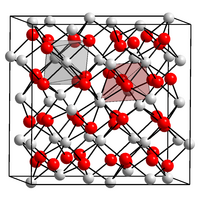
Photo from wikipedia
Abstract We have investigated the optoelectrical properties of the In2O3 thin films deposited with hydrogen and oxygen gas concentration variation during the sputtering process. As-deposited films have shown amorphous nature… Click to show full abstract
Abstract We have investigated the optoelectrical properties of the In2O3 thin films deposited with hydrogen and oxygen gas concentration variation during the sputtering process. As-deposited films have shown amorphous nature and post-annealing treatment has led to polycrystalline films with better optoelectrical properties. The hydrogen and oxygen gas concentration optimization has led to the In2O3:H films' with electrical mobility of ~80 cm2/V.s at the carrier concentration of ~1 × 1020 cm−3, and the resistivity of ~5 × 10−4 Ω cm. The better carrier mobility of the In2O3:H films in comparison to the pure In2O3 films is due to minimization of carrier scattering, after replacing some of the doubly ionized oxygen vacancies (in In2O3) with the singly charged hydrogen (in In2O3:H). The spectroscopic ellipsometry (SE) analysis of the In2O3:H films' have revealed the role of oxygen in the free carrier absorption in near-infrared wavelength region; apart from quantification of optical mobility, and plasma energy of the In2O3:H films. The post-annealed In2O3:H films’ carrier mobility obtained from the Hall and SE measurements have pointed out the influential role of carrier impurity scattering rather than the grain boundary scattering.
Journal Title: Materials Science in Semiconductor Processing
Year Published: 2020
Link to full text (if available)
Share on Social Media: Sign Up to like & get
recommendations!